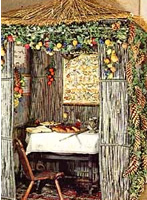 |
Sukkot
booth |
After the harvest from your threshing floor and your vineyards, you shall celebrate the Feast of Booths for seven days. (Deuteronomy 16:13)
You shall [do this] in order that future generations may know that I made the Israelite people live in booths when I brought them out of the land of Egypt. (Leviticus 23: 42-53)
The Jewish festival of Sukkot occurs at the end of the autumnal harvest. During the biblical period it was one of the three pilgrimage holidays,* when families would converge on Jerusalem to give thanks and offerup a token of the harvest: at Sukkot, these offerings would include grapes and olives.
For
the seven days and nights of the festival it is traditional to eat in
a temporary shelter constructed with a roof of branches. According to
the quotes above, this is in remembrance of the period the Israelites
spent in the wilderness. However it is more likely that the nomadic pastoral
Israelites would have lived in tents, and many now believe that the origins
of the Sukkot booth can be traced to temporary huts erected in vineyards
and fields for accommodation during the harvest.